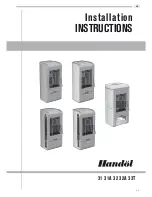
Primary Air (bottom control) – fully open
Secondary Air (top control) – adjust to suit
Thermostat Control – fully open (8)
Door – closed
Once the mineral fuel is burning well then add some
additional fuel (but not too much so that it ‘kills’
the mineral fuel that’s already alight), until there is a
good bed of burning fuel. Avoid stacking too much
fuel against the back and sides of the boiler as this
could potentially overheat the stove’s components and
cause permanent damage. Ideally, when fully burning
the fuel load should look like a shallow dome.
When burning good quality mineral fuels Secondary
Air (Airwash) should not be needed to keep the glass
clean, therefore the Secondary Air can be reduced or
shut off completely. The Primary Air control should
then be used to adjust the flame pattern in the early
stages. You may find that a combination of subtle
adjustments to both air controls may best suit your
individual requirements. Leave the Thermostat Control
fully open until the heating and hot water system is at
the desired temperature – this is usually after a couple
of hours and depends on the system requirements.
3 Refuelling
For best results: Just before you refuel...
Primary Air (bottom control) – fully open
Secondary Air (top control) – fully open
Thermostat Control – fully open (8)
After loading and when new fuel is burning well...
Primary Air – adjusted to suit
Secondary Air– fully close or adjust to suit
Thermostat Control – adjust to suit (0 – 8)
When refuelling it is better to use smaller fuel loads
more often which will provide you with a cleaner,
more efficient burn.
Immediately after refuelling, open the Primary Air to
maximise the combustion air delivered to the
remaining fuel so that when the new fuel is added it
can get quickly established without ‘damping’ the fire.
Spread the embers with a poker just before adding
the new fuel. Re-adjust the air settings once all the
fuel is burning normally.
Empty the ash pan regularly – at least once a day and
do not let the ash build up under the grate as this will
create a strong hot spot which could eventually warp
or burn-out your grate. It will also eventually limit the
flow of Primary combustion air and could affect the
stove’s performance.
4 Controlling the boiler temperature
As previously stated this will be very much a matter of
trial and error using the guidelines above. When the
stove has been running at operating temperature for a
number of hours the Thermostat Control, can be used
for simultaneous control of both the water
temperature and the burn rate of the mineral fuel
load (and therefore the heat into the room). To do
this, ensure the Primary and Secondary Air is fully
closed. Then simply control the flame pattern and
burn rate with the Thermostat Control. However, you
may still need to undertake some subtle adjustments
to both the Primary and Secondary Air supply to
achieve the correct balance of combustion air for your
stove and flue system draught.
EXTENDED BURNING
The Graphite Boiler is designed to allow extended
burning. To do this put a good fuel load into the stove
and allow it to burn for about 20 minutes in the
normal way. If burning wood, then limit the Secondary
Air supply and ensure the Primary Air supply is closed.
Adjust both the Thermostat Control and Secondary
Air to achieve a slower burn rate. If the glass begins to
soot up then add some more Secondary Air (Airwash).
Do not ‘starve’ the fuel of combustion air as this could
create a very inefficient smoky burn and cause heavy
soot and creosote build-ups in the flueway and fuel
system. The best setting to achieve the best burn and
cleanest glass will be a matter of experimentation.
For mineral fuels close the Secondary Air supply and
adjust the Primary and Thermostat Air supply to
achieve a slower burn rate.
When you return to your stove, check the ash pan
does not need emptying, then fully open all three air
supply controls. If the firebed shows that it still has
sufficient burning embers then simply add a small fuel
load as if lighting the fire from the start (see above)
and add more fuel until you have a good fire.
If you have been burning mineral fuels you will
probably need to riddle the firegrate to re-establish
the Primary Air flow. Do not add a full fuel load until
the firebed is hot and any initial small fuel load has
been allowed to fully ignite. A large ‘cold’ fuel load
could easily starve the embers of combustion air and
put out the fire.
After extended burning, always operate the stove on
full burn for approximately 30 minutes to clear away
any soot deposited in the flue system which have built
up during the extended burn session. Afterwards you
can then revert to your preferred operating levels.
During extended burning the stove glass may blacken
but if dry wood fuel has been used and a hot fire is
re-established then these deposits should quickly burn
off. However, if there are no burning embers and you
need to start the fire again, simply wipe any deposits
from the glass using kitchen roll or newspaper. Do not
use a damp cloth or proprietary cleaning fluids unless
you are sure that the stove glass is at room
temperature. Dipping the dry kitchen roll or
newspaper in the cold ash makes a very effective
scrubber.
18
Содержание GR910-B
Страница 4: ...4 GENERAL DIMENSIONS ...
Страница 22: ... 23 ...
















































